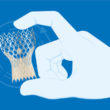Mitral regurgitation (MR) is the most frequent valve disease. Mitral transcatheter edge-to-edge repair (M-TEER) has been shown beneficial in high or prohibitive risk patients in cases of degenerative and functional MR. The PASCAL device has been shown safe and effective by the CLASP II, but we still need further research in clinical “real world” environments. ...
EXCEL Study: Complete vs. Incomplete Revascularization
Regardless of whether it is attempted through percutaneous coronary intervention (PCI) or myocardial revascularization surgery (MRS), complete revascularization (CR) is not always achieved. Overall, it is more frequent with surgery than with percutaneous treatment. Additionally, incomplete revascularization (IR) has proven to be associated with worse outcomes compared to CR. Researchers conducted an analysis of the...
SMART Trial: What is the Best Valve for Small Annuli?
Transcatheter aortic valve intervention (TAVI) has been shown beneficial over the years. However, a significant subgroup of patients with small aortic annulus, which make approximately one third of cases and have a higher incidence in women, face additional challenge, such as higher incidence of mismatch, reduced exercise capacity and shorter durability. Self-expanding and balloon expandable...
Peripheral Vascular Disease: Our Reality in Latin America, with the LATAM SOLACI Peripheral Registry
On the one hand, chronic peripheral vascular disease is on the rise. On the other, over the past 20 years, percutaneous coronary intervention (PCI) has gained considerable ground thanks to various new devices, replacing surgery as an alternative in most scenarios. Both strategies have shown similar results, but PCI has fewer complications and shorter hospital stays....
ACC 2024 | DEDICATE Trial: Transcatheter or Surgical Treatment of Aortic Valve Stenosis
In recent years, TAVR has been increasingly used; however, when it comes to younger, lower risk patients, its use is still challenged. In this context, there is limited information and we lack randomized studies on “real world” cohorts. The DEDICATE randomized 1.414 patients over 65 with severe symptomatic aortic stenosis. 701 of these patients received...
Temporal Trends in Transcatheter Aortic Valve Replacement for Isolated Severe Aortic Stenosis
A study by the Northern New England Cardiovascular Disease Group Consortium recently published online identified all patients with aortic valve stenosis treated with surgical or transcatheter aortic valve replacement between 2016 and 2022 in Maine, New Hampshire, and Vermont (USA). These patients were divided for analysis into three age groups: under 65 years old, 65...
Lithotripsy in the “Real World”: REPLICA EPIC-18 Study
Severe persistent calcification of the coronary arteries has been associated with different factors, such as advanced age, hypertension, dyslipidemia, smoking, and kidney failure, among others, and continues to be one of the challenges to stent implantation because of it impact on device advancing, drug release and adequate positioning. Intravascular lithotripsy (IVL) is a technique that...
TAVR in the Different Types of Aortic Stenosis
Aortic stenosis (AS) is classified according to gradient into high flow and high gradient (D1), low flow-low gradient with reduced ejection fraction (D2), and paradoxical low flow-low gradient with conserved ejection fraction (D3). D3 AS is characterized by ≥50% ejection fraction, but with systolic volume index ≤35 ml/min. Post TAVR evolution of D2 and D3...
NOTION Trial: 10 Year Outcomes, TAVR vs. SAVR in Low Risk Patients
Transcatheter aortic valve replacement (TAVR) has revolutionized the treatment of patients with severe aortic stenosis (AS). Randomized studies have shown the benefits of TAVR for treating inoperable patients, as well as high and intermediate risk patients. The NOTION (Nordic Aortic Valve Intervention Trial) randomized patients with low risk severe AS to TAVR or SAVR (surgical...
TENDER Study, Evolution at One Year
The use of transcatheter mitral valve intervention for the treatment of mitral valve regurgitation (MR) continues to evolve; at present guidelines only recommend it for inoperable or high surgical risk patients. So far, many devices have been assessed, some of which have shown promising results, but only for poor surgical candidates. Researchers looked into the...








